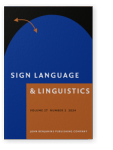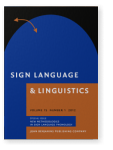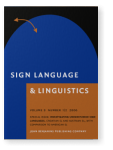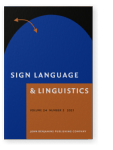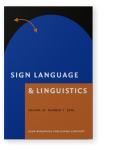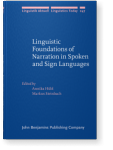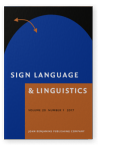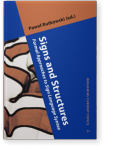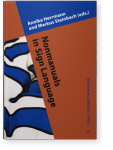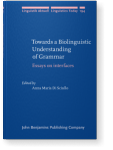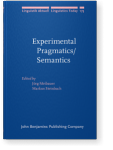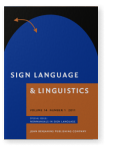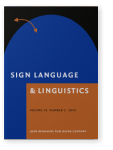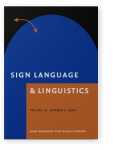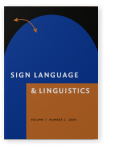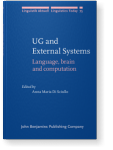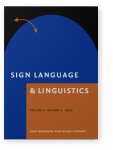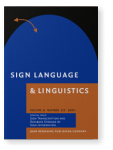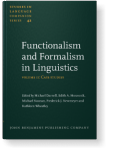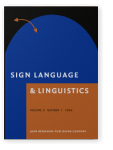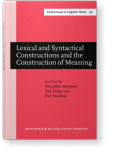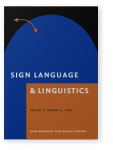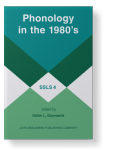Ronnie B. Wilbur
List of John Benjamins publications for which Ronnie B. Wilbur plays a role.
Journal
Titles
New Methodologies in Sign Language Phonology: Papers from TISLR 10
Edited by Diane Brentari and Ronnie B. Wilbur
Special issue of Sign Language & Linguistics 15:1 (2012) v, pp. 183
Subjects Electronic/Multimedia Products | Signed languages | Theoretical linguistics
Investigating Understudied Sign Languages - Croatian SL and Austrian SL, with comparison to American SL
Edited by Ronnie B. Wilbur
Special issue of Sign Language & Linguistics 9:1/2 (2006) v, 256 pp.
Subjects Signed languages | Theoretical linguistics
2024 The interaction of syntax, non-manuals, and prosodic cues as potential topic markers in Austrian Sign Language Sign Language & Linguistics: Online-First Articles | Article
Topic is often marked only by prosody across languages. In sign languages, prosody is expressed by features similar to those in speech: i.e., sign duration, velocity and amplitude of movement (cf. slope and range of pitch). Topicalized signs usually occur sentence-initially, are followed by a… read more
2021 Marking various aspects in Turkish Sign Language: bı̇t (‘finish’) and ‘bn’ Sign Language & Linguistics 24:2, pp. 182–225 | Article
Sign languages have been reported to have manual signs that function as perfective morphemes (Fischer & Gough 1999; Meir 1999; Rathmann 2005; Duffy 2007; Zucchi et al. 2010). Turkish Sign Language (TİD) has also been claimed to have such morphemes (Zeshan 2003; Kubuş & Rathmann 2009; Dikyuva… read more
2018 Wh-clefts as evidence of resultatives in ASL Sign Language & Linguistics 21:1, pp. 77–114 | Article
The status of syntactic resultative constructions has been disputed in the American Sign Language (ASL) literature. These are single sentences such as “Mary hammered the metal flat,” where two predicates share the same object and an event (hammered) causes the affected object (the metal) to… read more
2018 A new technique for analyzing narrative prosodic effects in sign languages using motion capture technology Linguistic Foundations of Narration in Spoken and Sign Languages, Hübl, Annika and Markus Steinbach (eds.), pp. 15–40 | Chapter
The present paper addresses prosody at a sentence level analysis within short narratives, developing a novel method based on a combination of data. Our first objective, then, is to establish the validity of our new method by confirming the findings of previous reports on Phrase Final Lengthening.… read more
2017 Two agreement markers in Austrian Sign Language (ÖGS) Sign Language & Linguistics 20:1, pp. 27–54 | Article
For many of the sign languages studied to date, different types of agreement markers have been described which express agreement in transitive constructions involving non-inflecting (plain) verbs and sometimes even inflected agreement verbs. Austrian Sign Language (ÖGS) belongs to the group of… read more
2015 The point of agreement: Changing how we think about sign language, gesture, and agreement Signs and Structures: Formal Approaches to Sign Language Syntax, Rutkowski, Paweł (ed.), pp. 103–139 | Article
This paper reconsiders arguments suggesting that sign language analyses must proceed differently to take into account their gestural, iconic origins. Lillo-Martin & Meier (2011) argue that agreement is ‘person marking’, shown by directionality. Liddell (2003, 2011) argues that directional verbs… read more
2013 The point of agreement: Changing how we think about sign language, gesture, and agreement Sign Language Syntax from a Formal Perspective: Selected Papers from the 2012 Warsaw FEAST, Rutkowski, Paweł (ed.), pp. 221–258 | Article
This paper reconsiders arguments suggesting that sign language analyses must proceed differently to take into account their gestural, iconic origins. Lillo-Martin & Meier (2011) argue that agreement is ‘person marking’, shown by directionality. Liddell (2003, 2011) argues that directional verbs… read more
2013 Nonmanuals, semantic operators, domain marking, and the solution to two outstanding puzzles in ASL Nonmanuals in Sign Language, Herrmann, Annika and Markus Steinbach (eds.), pp. 143–173 | Article
This paper provides an analysis of certain nonmanuals from a semantic perspective with respect to the different types of semantic operators they are associated with. The categories of operators include simple/monadic and tripartite/dyadic. This semantic analysis will explain different phonological… read more
2012 Guest Editors’ Preface New Methodologies in Sign Language Phonology: Papers from TISLR 10, Brentari, Diane and Ronnie B. Wilbur (eds.), pp. 1–10 | Miscellaneous
2012 What sign languages show: Neurobiological bases of visual phonology Towards a Biolinguistic Understanding of Grammar: Essays on interfaces, Di Sciullo, Anna Maria (ed.), pp. 265–276 | Article
The chapter presents analysis of the motion properties of the environment that humans use to parse natural scenes, and the kinematics of articulator (hand) motion in American and Croatian Sign Languages, asking whether the kinematic distinctions between linguistic categories in sign languages are… read more
2011 The development of conversational competence in children with Specific Language Impairment Experimental Pragmatics/Semantics, Meibauer, Jörg and Markus Steinbach (eds.), pp. 19–42 | Article
Two adult raters viewed videotapes of children with and without SLI in spontaneous conversations. Raters identified violations of conversational rules and assigned each to a category based on a system developed by Bishop and Adams (1989). Children with SLI produced significantly more violations… read more
2011 Nonmanuals, semantic operators, domain marking, and the solution to two outstanding puzzles in ASL Nonmanuals in Sign Language, Herrmann, Annika and Markus Steinbach (eds.), pp. 148–178 | Article
This paper provides an analysis of certain nonmanuals from a semantic perspective with respect to the different types of semantic operators they are associated with. The categories of operators include simple/monadic and tripartite/dyadic. This semantic analysis will explain different phonological… read more
2010 Early acquisition of sign language: What neuroimaging data tell us Sign Language & Linguistics 13:2, pp. 183–199 | Article
Early acquisition of a natural language, signed or spoken, has been shown to fundamentally impact both one’s ability to use the first language, and the ability to learn subsequent languages later in life (Mayberry 2007, 2009). This review summarizes a number of recent neuroimaging studies in order… read more
2010 Author’s Preface Sign Language & Linguistics 13:2, pp. 201–202 | Article
2010 The role of contact in the phonology of ASL Sign Language & Linguistics 13:2, pp. 203–216 | Article
2010 Author’s Afterword Sign Language & Linguistics 13:2, pp. 217–221 | Article
2009 Editor’s Preface Sign Language & Linguistics 11:2, pp. 241–242 | Subsection
2009 Editor's Afterword Sign Language & Linguistics 12:2, pp. 201–202 | Subsection
2006 Pronominal system in Croatian Sign Language Investigating Understudied Sign Languages - Croatian SL and Austrian SL, with comparison to American SL, Wilbur, Ronnie B. (ed.), pp. 95–132 | Article
In this article we present some fundamental properties of the Croatian Sign Language (Hrvatski Znakovni Jezik, HZJ) pronominal system. The most common functions of pointing in HZJ are pronominal, demonstrative, locative, possessive and reflexive. Examination of the first person pronoun shows that… read more
2006 Interrogative structures in Croatian Sign Language: Polar and content questions Investigating Understudied Sign Languages - Croatian SL and Austrian SL, with comparison to American SL, Wilbur, Ronnie B. (ed.), pp. 151–167 | Article
In this study, we investigate the interrogative structures in Croatian Sign Language (HZJ) with respect to the word order, manual question words, and nonmanual markers and their scope. Both polar and content questions mainly use specific nonmanual markers to indicate interrogative function. Polar… read more
2006 Phonological parameters in Croatian Sign Language Investigating Understudied Sign Languages - Croatian SL and Austrian SL, with comparison to American SL, Wilbur, Ronnie B. (ed.), pp. 33–70 | Article
We present an initial description of the sign parameters in Croatian Sign Language. We show that HZJ has a comparable phonological structure to other known sign languages, including basic sign parts, such as location, handshape, movement, orientation, and nonmanual characteristics. Our discussion… read more
2006 Word order in Croatian Sign Language Investigating Understudied Sign Languages - Croatian SL and Austrian SL, with comparison to American SL, Wilbur, Ronnie B. (ed.), pp. 169–206 | Article
This paper focuses on the basic word order of Croatian Sign Language (HZJ) and factors that permit alternative word orders to occur in sentences and in context. Although they are unrelated languages, the basic word order in HZJ is the same as in spoken Croatian: SVO.
One of the factors allowing… read more
2006 What does the study of signed languages tell us about ‘language’? Investigating Understudied Sign Languages - Croatian SL and Austrian SL, with comparison to American SL, Wilbur, Ronnie B. (ed.), pp. 5–32 | Article
Linguists focusing on what all languages have in common seek to identify universals, tendencies, and other patterns to construct a general model of human language, Universal Grammar (UG). The design features of this model are that it must account for linguistic universals, account for linguistic… read more
2006 Preface Investigating Understudied Sign Languages - Croatian SL and Austrian SL, with comparison to American SL, Wilbur, Ronnie B. (ed.), pp. 1–4 | Article
2006 Editor’s Preface Sign Language & Linguistics 7:2, pp. 125–127 | Miscellaneous
2005 Evidence from ASL and ÖGS for asymmetries in UG UG and External Systems: Language, brain and computation, Di Sciullo, Anna Maria (ed.), pp. 193–212 | Article
2002 Editor’s Afterword Sign Language & Linguistics 5:2, pp. 243–245 | Miscellaneous
2001 Content index (alphabetical) Sign Transcription and Database Storage of Sign Information, Bergman, Brita, Penny Boyes Braem, Thomas Hanke and Elena Antinoro Pizzuto (eds.), pp. 301–302 | Index
1999 A Functional Journey with a Formal Ending: What do brow raises do in American Sign Language? Functionalism and Formalism in Linguistics: Volume II: Case studies, Darnell, Michael, Edith A. Moravcsik, Michael Noonan, Frederick J. Newmeyer and Kathleen Wheatley (eds.), pp. 295–316 | Article
1999 Commentary on Fischer & Gough (1972) Sign Language & Linguistics 2:1, pp. 80–84 | Article
1999 A Prosodic/Pragmatic Explanation for Word Order Variation in ASL with Typological Implications Lexical and Syntactical Constructions and the Construction of Meaning: Proceedings of the bi-annual ICLA meeting in Albuquerque, July 1995, Verspoor, Marjolijn H., Kee Dong Lee and Eve Sweetser (eds.), pp. 89–104 | Article
1999 Metrical Structure, Morphological Gaps, and Possible Grammaticalization in ASL Sign Language & Linguistics 2:2, pp. 217–244 | Article
This paper reports regularities of stress placement at the phrasal level in American Sign Language (ASL) and identifies a category of signs (final pronouns) that appear to be exceptions. The group of exceptional pronouns predominantly comprises experiencer subject arguments, a category that does… read more
1999 Syntactic Correlates of Brow Raise in ASL Sign Language & Linguistics 2:1, pp. 3–41 | Article
Previous approaches to explaining brow raise behavior in American Sign Language (ASL) have claimed that it performs a semantic or pragmatic function, such as indicating that information is presupposed, given, or otherwise not asserted. However we show that this explanation cannot be extended to all… read more
1981 Theoretical phonology and child phonology: argumentation and implication Phonology in the 1980’s, Goyvaerts, Didier L. (ed.), pp. 403–430 | Article
